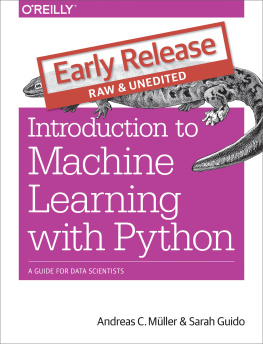Ethem Alpaydin - Introduction to machine learning
Here you can read online Ethem Alpaydin - Introduction to machine learning full text of the book (entire story) in english for free. Download pdf and epub, get meaning, cover and reviews about this ebook. year: 2020, publisher: MIT Press, genre: Romance novel. Description of the work, (preface) as well as reviews are available. Best literature library LitArk.com created for fans of good reading and offers a wide selection of genres:
Romance novel
Science fiction
Adventure
Detective
Science
History
Home and family
Prose
Art
Politics
Computer
Non-fiction
Religion
Business
Children
Humor
Choose a favorite category and find really read worthwhile books. Enjoy immersion in the world of imagination, feel the emotions of the characters or learn something new for yourself, make an fascinating discovery.

- Book:Introduction to machine learning
- Author:
- Publisher:MIT Press
- Genre:
- Year:2020
- Rating:4 / 5
- Favourites:Add to favourites
- Your mark:
- 80
- 1
- 2
- 3
- 4
- 5
Introduction to machine learning: summary, description and annotation
We offer to read an annotation, description, summary or preface (depends on what the author of the book "Introduction to machine learning" wrote himself). If you haven't found the necessary information about the book — write in the comments, we will try to find it.
Introduction to machine learning — read online for free the complete book (whole text) full work
Below is the text of the book, divided by pages. System saving the place of the last page read, allows you to conveniently read the book "Introduction to machine learning" online for free, without having to search again every time where you left off. Put a bookmark, and you can go to the page where you finished reading at any time.
Font size:
Interval:
Bookmark:
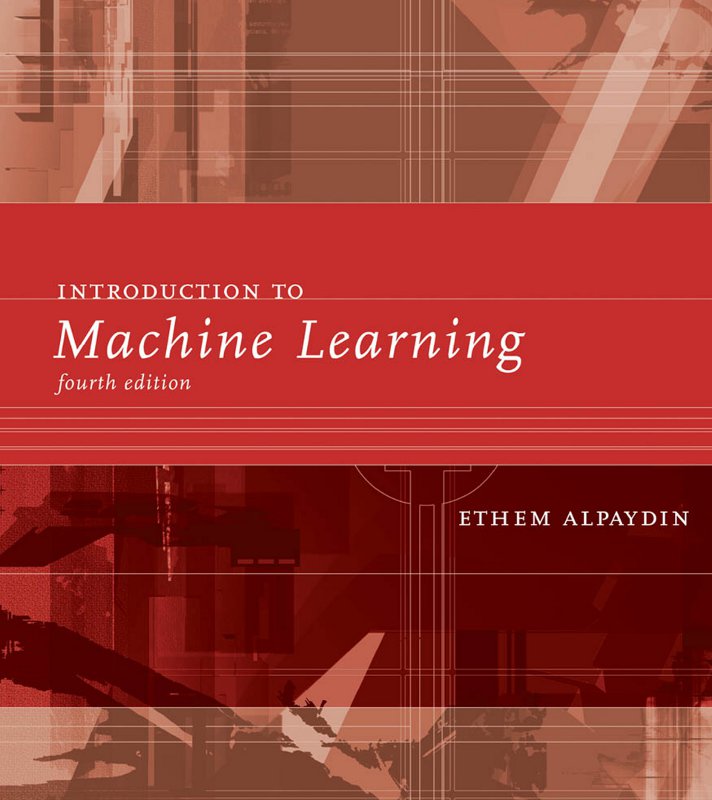
Introduction
to
Machine
Learning
Fourth
Edition
Adaptive Computation and Machine Learning
Francis Bach, Editor
A complete list of books published in The Adaptive Computation and Machine Learning series appears at the back of this book.
2020 Massachusetts Institute of Technology
All rights reserved. No part of this book may be reproduced in any form by any electronic or mechanical means (including photocopying, recording, or information storage and retrieval) without permission in writing from the publisher.
Typeset in 10/13 Lucida Bright by the author using  .
.
Library of Congress Cataloging-in-Publication Data
Names: Alpaydn, Ethem, author.
Title: Introduction to machine learning / Ethem Alpaydn.
Description: Fourth edition. | Cambridge, Massachusetts : The MIT Press, 2020.
| Series: Adaptive computation and machine learning series
| Includes bibliographical references and index.
Identifiers: LCCN 2019028373 | ISBN 9780262358064
Subjects: LCSH: Machine learning.
Classification: LCC Q325.5 .A46 2020 | DDC 006.3/1dc23
LC record available at https://lccn.loc.gov/2019028373
d_r0
Brief Contents
Machine learning underlies the coolest technologies of today. From face recognition to self-driving cars, from speech recognition to translation, applications that are increasingly becoming a part of our everyday lives all have some learning components; actually most such systems would not have been possible today if not for machine learning. With increasing availability of data and the computing power to process it, we are seeing the tendency more and more to let the system learn by itself, either from collected data or by trial and error, instead of being programmed explicitly for the task.
A self-driving car is trained with data that contains many more traffic scenarios or more varied road and weather conditions than can be lived by even the most experienced human driver. AlphaGo, the program that learns to play Go, has played and learned from more games than any human player can play in a lifetime, and because it was playing against itself and learning all the while, it was as if it was competing against better and better players. A learning program trained to translate, say, from English to French, sees more sample texts than any human translator.
Machine learning is one of the hottest research areas in computer science. As digital technology increasingly infiltrates our lives, more data are continuously generated and collected. Our computer systems are also getting faster and can now process bigger data. The theory underlying the learning algorithms is also advancing rapidly. This parallel evolution of theory, computing, and data has grown even stronger since the third edition appeared in 2014.
In this last decade, deep learning has risen to be the dominant approach in machine learning. Artificial neural networks, popular in the late 1980s and early 1990s, were successful in some domains; Tesauros TD-Gammon network that learns to play backgammon and LeCuns handwritten digit recognition network immediately come to mind. But it was difficult to find large data sets then, and computing power was limited. In recent years, with more data and cheaper and faster processors, it has become possible to build and train deep networks with many layers and units, and they turned out to be surprisingly successful in many domains. Another driving force has been the availability of open software platforms that make programming such deep networks very easy. Networks that are deeper than LeCuns LeNet now are being used in more complicated vision applications, including face recognition, generating captions for images, and self-driving cars. A network that is deeper than Tesauros TD-Gammon has learned to play Go, a game long believed to be beyond the abilities of artificial intelligence.
One of the most interesting aspects of deep learning is that learning is end to end. We provide only the input at the beginning and the desired output at the very end, and any transformation needed in between is automatically learned by the many intermediate, hidden layers of the network. Such networks typically have a two-stage structure, where the first stagethe encodertakes the input and in the early layers of the network compresses it into an intermediate code. The second stagethe decodertakes this as input and in the final layers of the network composes the output. End-to-end learning implies that the two are trained together, and the format of the intermediate code between them is also automatically determined.
We are familiar with such structures in computer science. A compiler, for example, has a front end that reads in the source code, analyzes it lexically and syntactically, and generates an intermediate representation; the back end takes this intermediate representation and generates the object code. A deep network is similar, except that both ends are learned, and are learned together.
Consider a self-driving car. Let us say it has a camera that sees the road ahead and the output is the angle of the steering wheel. Typically such a system would be composed of two modules back to back. There would be a perception module that takes in the sensory data from the camera, processes it, and generates an abstract representation summarizing the scene in terms of features that are critical for steering, and there would be an action module that generates the steering output based on that. The two modules would be implemented by two teams composed of engineers of different skills who would work almost independently, except in defining the intermediate representation that is the interface of the two modules.
A deep network trained end to end contains both modules and trains them together. A deep network has early convolutional layers that process the image and generate successively abstract representations of the scene, and roughly speaking, those early layers correspond to the perception module. Afterward, there are the so-called fully connected layers, whose task is to synthesize the output, which in this case corresponds to choosing the right action. Whatever intermediate representation is necessary between the two, or whatever features need to be detected by the perception module, are all learned from the data, so as to maximize the accuracy at the output, at the very end of the network. Deep networks that are used in many applications have this perception-action, analyzer-synthesizer, or encoder-decoder structure.
In accordance with recent advances, the changes in the new edition are mostly related to neural networks and deep learning.
on multilayer perceptrons has two new sections: Autoencoders, which have become popular with deep neural networks, are treated in detail in one; the other discusses the word2vec network that is interesting both in the novel way the task is defined and because it has become a popular method for representing words in natural language processing tasks.
A new on deep learning has been added. It extends the discussion of multilayer perceptrons and contains sections on training deep neural networks, regularizing them so they learn better, structuring them to improve learning, for example, through convolutional layers, and their recurrent extensions with short-term memory necessary for learning sequences. There is also a section on generative adversarial networks that have found an impressive array of applications in recent years.
Next pageFont size:
Interval:
Bookmark:
Similar books «Introduction to machine learning»
Look at similar books to Introduction to machine learning. We have selected literature similar in name and meaning in the hope of providing readers with more options to find new, interesting, not yet read works.
Discussion, reviews of the book Introduction to machine learning and just readers' own opinions. Leave your comments, write what you think about the work, its meaning or the main characters. Specify what exactly you liked and what you didn't like, and why you think so.

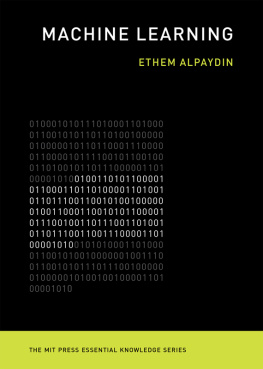
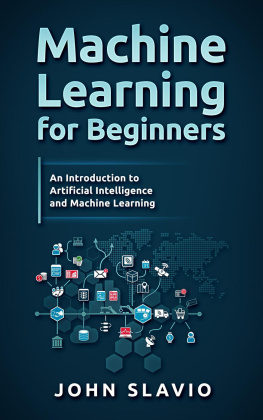
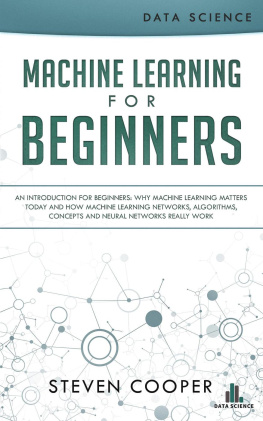
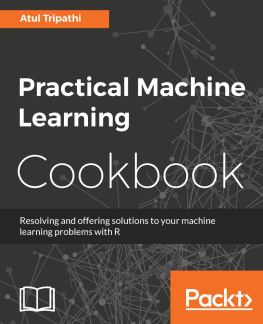
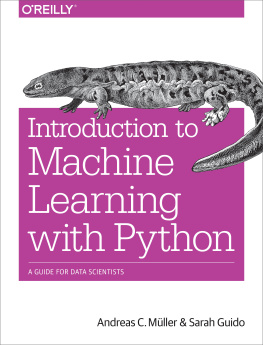

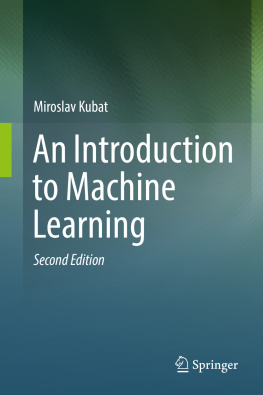
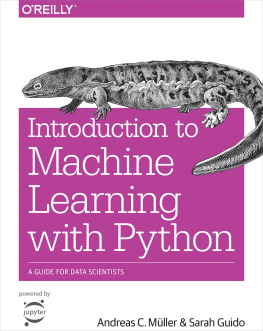
![Daniel D. Gutierrez [Daniel D. Gutierrez] - Machine Learning and Data Science: An Introduction to Statistical Learning Methods with R](/uploads/posts/book/119585/thumbs/daniel-d-gutierrez-daniel-d-gutierrez-machine.jpg)
